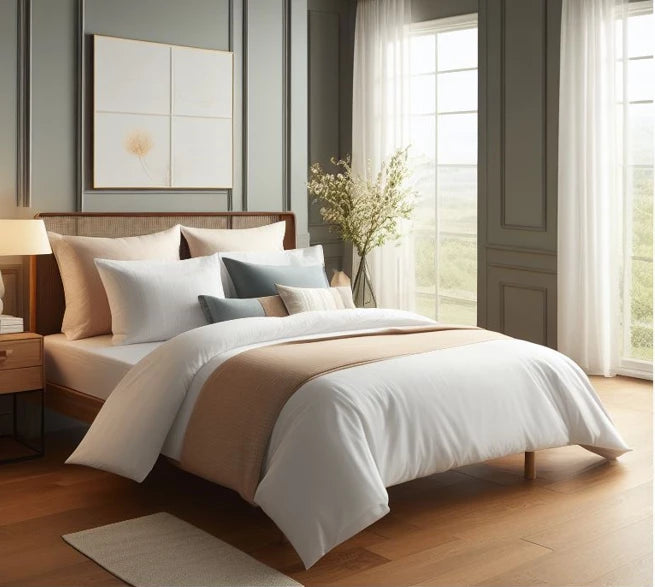When we purchase new bed sheets, the attention tends to go towards the look, the print, or perhaps the price tag. Few people flip the label over and see what the sheet is actually made of. And even then, the actual difference does not appear on the store shelf. It appears later when you actually sleep on the sheets for a couple of nights.
That's when you begin to pay attention to little things: how the sheet feels against your body, if it makes you sweat during the night, or how it looks after washing. These little things quietly distinguish pure cotton sheets from blended materials such as poly-cotton. We don't pay attention to them, yet they are more important than we know.
The First Touch vs. The Long Run
When you first lay hands on a blended fabric bed sheet, it tends to feel smoother and appear neater. It barely wrinkles, so it looks absolutely flawless in bed.
Cotton sheets, however, don't necessarily make a good impression upon initial appearance; they quickly wrinkle and lack the glistening shine. But let them break in. Cotton gets soft after a few washes. It gradually becomes softer each time you sleep on it. Blends, however, typically remain the same on day one, smooth, sure, but lacking that natural "broken in" feel. It's like sleeping in brand-new shoes daily versus shoes that acclimate to your feet over time.
Why Cotton Breathes Better
This is one of those things you only realise at 2 a.m. when you're lying awake and turning over. Cotton breathes by nature; it allows air to flow through, so your body is cooler in summer and equalised in moderate winters.
Sheets blended with polyester tend to trap heat due to the polyester material. You might wake up sweating and too hot, and fault the fan or the climate, when actually, it's the sheet refusing your skin to breathe.
Wrinkles That Tell a Story
Cotton wrinkles too quickly, people complain. That's true. But those wrinkles are the charm, beautiful and soft, they mean the sheet is natural and not some impossibly perfect confection. Cotton isn't faking being perfect, and your body actually sleeps better on its natural creases.
Blended fabrics, by contrast, stay crease-free. They look neat and sharp, but sometimes that neatness comes at the cost of comfort. The polyester mix makes the fabric stiffer, which can look hotel-like but doesn’t always feel homely.
Sheets and Skin: The Quiet Connection
If you’ve ever woken up with a bit of redness or itchy skin, your sheet could be the culprit. Pure cotton is kind to the skin; it absorbs sweat, dust, and oils and then releases them easily when washed. Blended materials can be a bit tougher. They don't hug your skin as well and sometimes retain sweat, which isn't good for sensitive skin. It's like the difference between wearing a cotton t-shirt and a polyester one on a hot day; you immediately know which feels more comfortable.
Which One Lasts Longer?
Now, to be honest, mixed materials normally triumph in longevity. Polyester toughens them, making them durable and resistant to wear and tear, hence making hotels and guest houses prefer to use them. They can endure dozens of washings without losing their shape. Cotton, though tough, also wears out more quickly. The fabric gets thin after a while, and tiny tears form. But there is a catch to this: cotton matures beautifully. The more you wear it, the softer and more comfortable it becomes. People tend to fondly keep their old cotton sheets, but blended ones stay long but fail to impart the same kind of warmth.
How They Age With You
Cotton sheets gradually fade with each wash. Some consider it a defect, but others adore that "lived-in" appearance. It is warm and almost retro. Blends do retain their colour brighter for longer, but they do tend to get small balls of yarn (pilling) and begin to feel scratchy. So they appear nice on the outside, but they don't always grow old in a comfortable way.
Washing: Work vs. Reward
Yes, cotton is more high-maintenance. It wrinkles quickly, dries more slowly, and frequently requires ironing if you prefer having a tidy bed. Blended fabrics, on the other hand, are low maintenance, quick dry, less wrinkly, and easy to fold. But the hassle is worth the reward with cotton. If you wash it well, nothing beats the crisp, fresh, and soft sensation of cotton sheets. It's like homemade cooking; it’s time-consuming, but the food always tastes better than fast food.
Comfort Throughout the Seasons
Cotton is a do-it-all fibre. In summer, it keeps you cool; in winter, it's comfortable under blankets without making you sweat. Blended fabrics can be tricky. They feel fine in cooler months, but in summer, they often make the nights warmer than they need to be. If you’ve ever struggled to sleep on a hot night, it might not be the heat outside; it could be your sheet trapping it.
The Emotional Value of Cotton
Here's something that's seldom spoken: people get attached to cotton sheets. Even when they thin out or get faded, families tend to retain them for years. Cotton sheets that are old sometimes find their way into the guest bedroom, or get cut into gentle cleaning rags, or simply put away because they feel too precious to discard. Blended materials hardly have that attachment. They perform their function, but when they're spent, they're simply replaced without hesitation.
So, Which Should You Choose?
If you desire easy maintenance, bright colours, and longevity, mixed fabrics are convenient. They're low-cost, easy to take care of, and fine for locations where sheets receive heavy use. But if comfort, breathability, and the type of sleep in which you wake up feeling wonderful are your top priorities, pure cotton is the winner.
The wrinkling, the fading, the softening with age, they all contribute to a character and a comfort that sheet blends just can't match. At the end of the day, it's not all about labels on fabric. It's about how you feel when you go to bed after a long day. And sometimes those little unnoticed things in your bed sheet make all the difference to your sleep.
Written by Shivangi Singh


